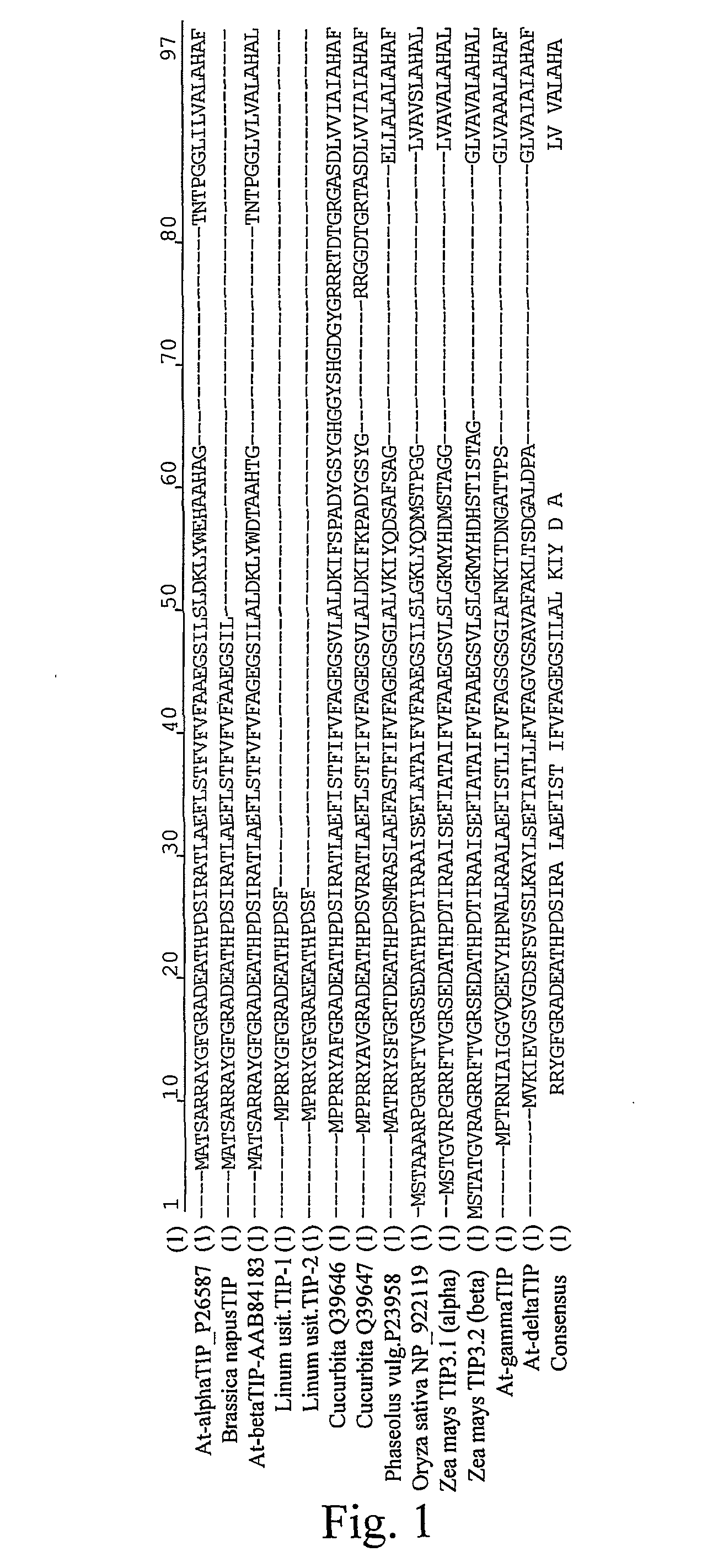Expression cassettes for seed-preferential expression in plants
a technology of plant genes and cassettes, applied in the field of expression cassettes, can solve the problems of difficult to distinguish between certain tip homologous proteins, difficult to predict the expression profile of tip genes, and inability to predict the specificity of that gen
- Summary
- Abstract
- Description
- Claims
- Application Information
AI Technical Summary
Benefits of technology
Problems solved by technology
Method used
Image
Examples
example 1
Generation of Transgenic Plants
[0417]1.1 Generation of Transgenic Arabidopsis thaliana Plants
[0418]For generating transgenic Arabidopsis plants Agrobacterium tumefaciens (strain C58C1-[pMP90]) is transformed with the various promoter::GUS vector constructs (see below). Resulting Agrobacterium strains are subsequently employed to obtain trans-genic plants. For this purpose a isolated transformed Agrobacterium colony is incubated in 4 ml culture (Medium: YEB medium with 50 μg / ml Kanamycin and 25 μg / ml Rifampicin) over night at 28° C. With this culture a 400 ml culture of the same medium is inoculated and incubated over night (28° C., 220 rpm). The bacteria a precipitated by centrifugation (GSA-Rotor, 8.000 U / min, 20 min) and the pellet is resuspended in infiltration medium (1 / 2 MS-Medium; 0.5 g / l MES, pH 5.8; 50 g / l sucrose). The suspension is placed in a plant box (Duchefa) and 100 ml SILVET L-77 (Osi Special-ties Inc., Cat. P030196) are added to a final concentration of 0.02%. The p...
example 2
Growth Conditions for Plants for Tissue-Specific Expression Analysis
[0423]To obtain 4 and 7 days old seedlings, about 400 seeds (Arabidopsis thaliana ecotype Columbia) are sterilized with a 80% (v / v) ethanol:water solution for 2 minutes, treated with a sodium hypochlorite solution (0.5% v / v) for 5 minutes, washed three times with distillated water and incubated at 4° C. for 4 days to ensure a standardized germination. Subsequently, seeds are incubated on Petri dishes with MS medium (Sigma M5519) supplemented with 1% sucrose, 0.5 g / l MES (Sigma M8652), 0.8% Difco-BactoAgar (Difco 0140-01), adjusted to pH 5.7. The seedlings are grown under 16 h light / 8 h dark cyklus (Philips 58W / 33 white light) at 22° C. and harvested after 4 or 7 days, respectively.
[0424]To obtain root tissue, 100 seeds are sterilized as described above, incubated at 4° C. for 4 days, and transferred into 250 ml flasks with MS medium (Sigma M5519) supplemented with additional 3% sucrose and 0.5 g / l MES (Sigma M8652),...
example 3
Demonstration of Expression Profile
[0434]To demonstrate and analyze the transcription regulating properties of a promoter of the useful to operably link the promoter or its fragments to a reporter gene, which can be employed to monitor its expression both qualitatively and quantitatively. Preferably bacterial β-glucuronidase is used (Jefferson 1987). β-glucuronidase activity can be monitored in planta with chromogenic substrates such as 5-bromo4-Chloro-3-indolyl-β-D-glucuronic acid during corresponding activity assays (Jefferson 1987). For determination of promoter activity and tissue specificity plant tissue is dissected, embedded, stained and analyzed as described (e.g., Bäumlein 1991).
[0435]For quantitative β-glucuronidase activity analysis MUG (methylumbelliferyl glucuronide) is used as a substrate, which is converted into MU (methylumbelliferone) and glucuronic acid. Under alkaline conditions this conversion can be quantitatively monitored fluorometrically (excitation at 365 nm...
PUM
| Property | Measurement | Unit |
|---|---|---|
| Temperature | aaaaa | aaaaa |
| Fraction | aaaaa | aaaaa |
| Fraction | aaaaa | aaaaa |
Abstract
Description
Claims
Application Information
 Login to View More
Login to View More - R&D
- Intellectual Property
- Life Sciences
- Materials
- Tech Scout
- Unparalleled Data Quality
- Higher Quality Content
- 60% Fewer Hallucinations
Browse by: Latest US Patents, China's latest patents, Technical Efficacy Thesaurus, Application Domain, Technology Topic, Popular Technical Reports.
© 2025 PatSnap. All rights reserved.Legal|Privacy policy|Modern Slavery Act Transparency Statement|Sitemap|About US| Contact US: help@patsnap.com

